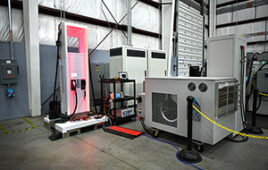RICHLAND, Wash. –
Two innovations developed by researchers at the Department of Energy’s Pacific Northwest National Laboratory were recognized by R&D Magazine today as among the past year’s 100 most significant scientific and technological products or advances.
The innovations were cited for their potential to lead to greater use of electric vehicles and reduce the time needed to recharge consumer electronic products, as well as create cleaner air in confined spaces such as submarines.
PNNL has now won 89 R&D 100 Awards — sometimes referred to as the “Oscars of Innovation” — since the program began in 1963. PNNL won its first R&D 100 award in 1969 for a device that detects flaws in welds during production.
“Congratulations to this year’s R&D 100 award winners,” said Energy Secretary Steven Chu. “The research and development at the Department of Energy’s laboratories continues to help the nation meet our energy challenges, strengthen our national security and improve our economic competitiveness.”
PNNL staff involved in developing these innovations will be honored at the annual R&D 100 Awards ceremony in Orlando on Nov. 1.
This year’s winning innovations from PNNL are:
Shared with Vorbeck Materials Corp. and Princeton University
New battery materials developed by PNNL and Vorbeck Materials Corp. of Jessup, Md., will enable electric vehicles and consumer electronic products to recharge in a fraction of the time currently required.
In collaboration with Vorbeck and Ilhan Aksay at Princeton University, PNNL demonstrated that small quantities of graphene — ultra-thin sheets of carbon atoms — can dramatically improve the performance and power of lithium-ion batteries. The pioneering work could lead to the development of batteries that last longer and recharge quickly, drastically reducing the time it takes to charge a smartphone to as little as ten minutes and an electric vehicle to just a few hours. Lithium-ion batteries also are used to power laptops, power tools and other electronic devices.
Electronics and auto manufacturers would like to develop the next generation of batteries using low-cost materials such as titanium dioxide to replace the expensive materials used today. But titanium dioxide on its own doesn’t perform well enough to serve as a replacement. To test whether graphene, a good electronic conductor, could help, PNNL researchers developed a new method to synthesize self-organizing mixtures of graphene and titanium dioxide. Structural analysis studies of the material were conducted with scientists at EMSL, a Department of Energy national user facility located at PNNL. When they compared how well the new combination of electrode materials charged and discharged electric current, the electrodes containing graphene outperformed the standard titanium dioxide by up to three times.
Vorbeck has a licensing option to bring lithium batteries incorporating graphene technology to market for use in consumer electronic devices, tools, and electric vehicles. They also are partnering with Hardwire LLC of Pocomoke City, Md., to integrate the new batteries into hybrid military vehicles.
Shared with Steward Advanced Materials
Aboard the U.S. Navy’s fleet of more than 70 submarines are thousands of sailors who spend weeks or even months isolated deep underwater. Here, shipboard air purification systems are critical to sailor health, quality of life and mission operations.
As early as 2014, U.S. Navy submarines may be fitted with the PNNL-developed Advanced Carbon-dioxide Removal Unit. The ACRU is a versatile air purification system that captures carbon dioxide directly from the atmosphere within a submarine, while providing a more environmentally friendly removal process. The system replaces a bulky, heavy and corrosive liquid process that has been used for more than half a century.
The ACRU is a nanotech-based technology that employs a novel granular sorbent material, developed by PNNL, to efficiently and effectively target and remove carbon dioxide from breathing air. The sorbent material, called SAMMS® for Self-Assembled Monolayers on Mesoporous Supports, regenerates itself, allowing for repeated air purification cycles over long stretches of time.
The air purification technology is a new application of an innovation that was previously developed by PNNL to remove heavy metal contamination from ground and surface waters. The SAMMS materials can absorb large quantities of contaminants from liquid as well as airborne contaminants without creating secondary waste, which can then be disposed as nonhazardous waste.
The manufacturing rights for the new sorbent material are licensed to Steward Advanced Materials of Chattanooga, Tenn., and the first ACRU that will employ the sorbent for air purification when installed is being manufactured by the Hamilton Sunstrand Corp., a United Technologies company with headquarters in Hartford, Conn.
In addition to submarines, PNNL researchers say the system could potentially be used in any confined spaces where air cleansing is critical, such as in underwater re-breather scuba gear, in space-based vehicles or in spacesuit air rejuvenation systems.
Tags: Energy, Awards and Honors, Batteries





